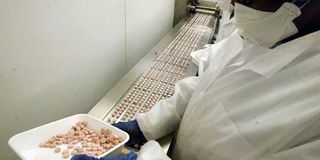Generic drugs are the key to lowering the cost of healthcare

Employees of Gabonese pharmaceutical factory Sogafam collect pills at the plant. Sogafam was the first pharmaceutical plant to make generic drugs against HIV/AIDS and malaria infections in Africa. Kenya recently unveiled an effective and affordable generic ARV drug, DTG. PHOTO | AFP
What you need to know:
- Misconceptions against generics are fuelled by the thought process that if something is cheap, then it’s not the best quality. This is not an absolute truth.
- The active ingredients (what makes the drug work) are the same in generic and branded medicines. What makes them different are things like shape, size and colour, or the the excipients (inactive ingredients) used.
- Generic equivalents of branded medicines work as effectively as the innovator drugs because they have the same active ingredients, in the same dosage and the same dosage amount.
The healthcare system in Kenya has undergone significant changes that are meant to improve service delivery, among them, the devolvement of its management to the county governments and the introduction of universal healthcare through the National Hospital Insurance Fund (NHIF).
However, there are serious challenges that are hindering the progress of the sector such as industrial strikes by nurses and doctors, the lack of medicines and other vital equipment key to the delivery of good services in public health institutions. Most Kenyans visiting public hospitals are often forced to buy medicines from private chemists as some hospitals are not stocked with the commonly used medicines. This exposes them to risks such as fake and unsafe medicines.
Concerns about counterfeits are so high, that most people think that generic drugs are counterfeits. Intensive consumer education is needed in this area, as the public still holds some misconceptions about generic medicines. Some think or confuse them with counterfeit medicines, as they are cheaper than branded drugs. This misconception works against a government that has embraced the use of generic drugs, and supplies generic versions of branded medicines at significantly lower prices.
The high cost of medical care in Kenya is partly due to the high cost of medication. The cost of drugs can make up about half or an average of 45 per cent of patients’ hospital bills.
This cost can significantly be reduced by the use of generic drugs. Misconceptions against generics are fuelled by the thought process that if something is cheap, then it’s not the best quality. This is not an absolute truth. I’d like to address the root problem of this notion, particularly in medicines, by clearly explaining what generic and brand medicines are.
EQUALLY GOOD
Some patients believe that generic drugs are inferior to brand name drugs, because they differ in price, colour, markings, shape or size. Although there may be stark differences, the fact of the matter is that both generic and brand name drugs have identical active ingredients. The term ‘active ingredient’ simply means the ingredient or the chemical substance that makes the drug work. Understanding this makes all the difference.
The active ingredients (what makes the drug work) are the same in generic and branded medicines. What makes them different are things like shape, size and colour, or the the excipients (inactive ingredients) used. The excipients used by a manufacturer may make the product slightly different, for example, the dye. That’s why some pain relievers may be pink, white or off-white. These slight differences are only important in rare cases when a patient has an allergy or sensitivity to one of the excipients used.
What makes generic drugs cheaper is that the manufacturer doesn’t have the expense of researching and developing a new chemical entity, like their brand medicine counterparts.
After a brand drug is discovered, the manufacturer gets a patent to solely produce that drug (so that they can recover the costs of discovery) and the patent period can last up to 20 years. After the patent period is over, generic manufacturers can then start manufacturing the same drug. Also important to note is that the same company that makes the brand name drug may also produce the generic version.
That’s why there’s a huge cost difference between generics and brand name medicines. Generic equivalents of branded medicines work as effectively as the innovator drugs because they have the same active ingredients, in the same dosage and the same dosage amount (for example 20 mg or 40 mg). Generics are also in the same dosage form (that is, it needs to be available in the same form as the original—for example, as a liquid, pill, etc.) It must also deliver similar amounts of the drug to the bloodstream, within a similar time period as the brand name drug.
Wider use of generic drugs will result in significant reduction in the cost of drugs; the savings will be passed on to the patient. Insurance companies will also save money and in turn give more affordable premiums for patients to get treatment at a cheaper cost. Locally, the MYDAWA app, that allows users to buy quality and affordable medicines online, will start selling its own generic MYDAWA products to increase access to quality and affordable medicines to all Kenyans. Generic drugs present a safe, effective, and affordable method to decrease overall healthcare costs for a patient.
Dr. William Mwatu is the MYDAWA app lead consultant and the chairman of Kenya Association of Pharmaceutical Industry (KAPI)


